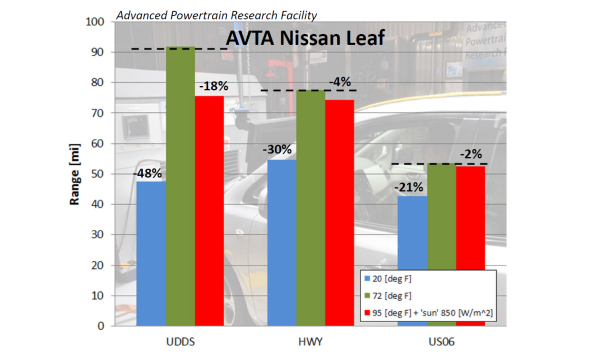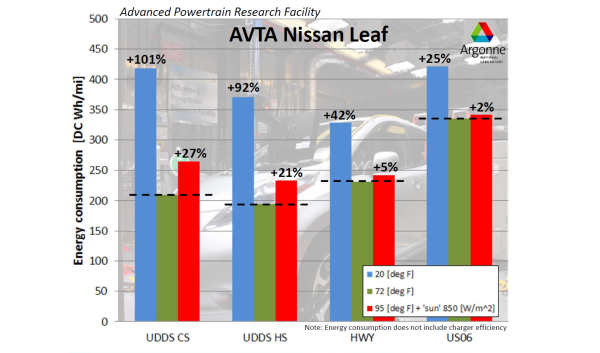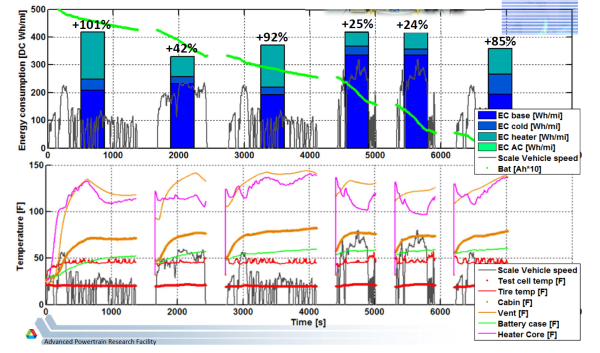The Tesla Model S Controversy: Understanding the Effects of Temperature on Electric Vehicle Efficiency and Range
by Vivek Gowri on February 18, 2013 4:22 PM EST- Posted in
- Auto
- Electric Vehicles
- Tesla Model S
- Nissan Leaf
Thermal Effects on Energy Consumption and Range
Looking at energy consumption, right off the bat, we can see that cold weather has a significant impact on EC - nearly double in urban driving, 40% more in the highway cycle, and 25% on the US06. It’s worth noting here: the Leaf has an 80 kW electric motor, a 24 kWh battery, and a 5 kW resistive heating element.
When broken down further, into a base load case (driving cycle EC at 72F), the amount of extra energy needed to drive the cycle at 20F (listed as EC cold), and then the heater load required to maintain a cabin temperature of 72F, we can see that a significant portion of the additional energy consumption is down to the heater. As with most gasoline cars, driving in sub-freezing temperatures only makes the car about 10% less efficient before heater loads are considered. The mechanically-driven heating elements in conventional vehicles add another 5% or so in terms of mechanical efficiency loss, while obviously the electric heater in the EV is far more costly from an energy consumption standpoint even though it doesn’t increase mechanical losses at all.
(Note: graphs were created by ANL using the raw 10Hz data instead of the filtered 1Hz data available on D3. Available as part of APRF's AVTA Nissan Leaf testing analysis and summary, as presented by Dr. Henning Lohse-Busch. Full presentation available here.)
And while energy consumption is a big deal, range is the be-all, end-all concern for most consumers. With the heater on, that’s a decrease in range by anywhere from 20-50% depending on your drive cycle. That’s a lot. And you can just look at the APRF’s full charge tests at 20F and 72F to see what I mean:
 Think about that - this is a car that, at launch, Nissan claimed had a 100 mile range. My own real-world driving suggests 80-85 a decent estimate. EPA says that number is closer to 73. The APRF’s instrumented testing backs that up (74.1 mile range at 72F), but the same instrumented testing, in 20F weather? 46 miles. That’s it.
Think about that - this is a car that, at launch, Nissan claimed had a 100 mile range. My own real-world driving suggests 80-85 a decent estimate. EPA says that number is closer to 73. The APRF’s instrumented testing backs that up (74.1 mile range at 72F), but the same instrumented testing, in 20F weather? 46 miles. That’s it.













102 Comments
View All Comments
shokunin - Monday, February 18, 2013 - link
There's several factors that affect range in an EV, the heater/HVAC as described in the article.Active heating and cooling of the battery pack. The ability to maintain temperature of the pack is paramount to keeping the battery operating within thermal limits, whether from weather or excessive current draw (driving fast) creating heat.
Driving style and speed. The faster you drive, the increased wind resistance uses more energy the faster you drive. This is also due to the fact that many EV's simply have one gear, there is no "overdrive" gear on an EV.
For the Model S, it takes more energy getting the car "up to speed" say 40-50 than it is staying at that speed. Ironically, in the city driving with lots of stop lights, it will use more energy than coasting along the freeway.
The NYT writer did a poor job explaining these and explaining the fact that one has to change habbits when it comes to an EV. Fully charge the car overnight, and when you are at a Supercharger, charge to full. You don't fill up your car to make it to the next gas station, you just fill it up to full. When you take a road trip on an ICE, you fill up whenever you've got a 1/4 tank left. He sort of missed the common sense part of charging.
mchart - Monday, February 18, 2013 - link
I had thought the high-end sports car like EV's had at least a two gear transmission.I know for a fact that there are plenty of high-'output' racing EV's that are linked to a two speed transmission. A 'driving applicance' (Car that people who just need A-B transportation buy) doesn't need gearing though. Even more so in the US given the fastest most people ever go is 60-70mph.
Funnily enough; I'd only ever buy an EV right now for performance reasons. Not for going 'fuel-less' reasons. The essentially straight as an arrow torque curve of an electric motor is amazing for racing application.
DParadoxx - Monday, February 18, 2013 - link
While I appreciate seeing this sort of article on AT you needn't insult Musk's article. He identified inaccuracies in the NYT article and provided clear and easy to read graphs to back up his argument. Several of your graphs by comparison are crowded and difficult to read, even for an engineer.relztes - Monday, February 18, 2013 - link
Well, Musk's article really was exaggerated. Broder spent less than 2 miles out of 500 over 75 mph, but Musk made a big deal out of it. Same for the half mile around the parking lot, which would have to be the world's weakest attempt at draining a battery. He points out the 40 miles for which the heater was set at 72-74 F after Broder noted the declining range, but ignored the last 60 miles of that leg where the heater was set at 64-66 F.Now Broder did seem to exaggerate about how slow he was driving, and some of his decisions were pretty stupid. The decision to unplug at 35 miles was by far the dumbest. I'm really curious about Broder's claims that Tesla gave him bad advice, because he mentioned some really stupid things. Tesla might want to reevaluate the employees answering the phones. Even so, you'd have to be an idiot to trust some of that stuff. Who could possibly believe that frequent acceleration and braking will extend the range of your car?
Anyway, I completely agree with Vivek's assessment of Musk's article as vitriolic. His legitimate points were drowned out by his cries of "OMG HE DROVE 80+ MPH!!" when only a small portion of the drive was even over 70 MPH.
jonvaustin - Monday, February 18, 2013 - link
The fundamental problem is basically the whole article. If a EV is to be successful the range has to be there for the right price, a good number of miles off a charge, and about the same experience as we currently have.We have what 100 years of cars under our belt now and for the longest time operation has been a similar experience that is taught in a persons teens and carried throughout his or her life time. For a EV to be mainstream for that consumer to have to take into account temperatures, this or that is foolish. Why it will never take off.
A good example is Apple with the iPhone 4. It got crappy reception from improper antenna placement and the solution was to tell people to hold it the right way? That is fail. Case in point future models fixed the issue. To tell a consumer that you have to hold the phone a certain way and not the way you naturally hold it was not to popular. The same is with EV cars.
Another case is why we all use the slow inefficient QWERTY keyboard. Why? I learned it as a kid because my parents learned it that way. There are a dozen better solutions and ZERO catch on primarly because of that reason.
To ask me to learn about battery dynamics and to drive differently then I currently do in my gas based car will never work for the general population to be successful. What needs to happen is a radical breakthrough in energy storage tech so it becomes a mute issue.
Luke212 - Monday, February 18, 2013 - link
New York Times article link is broken in first paragraphGalcobar - Monday, February 18, 2013 - link
One area neither side in this dispute has addressed -- that I've read -- is whether extremely cold temperatures affect the accuracy of the car's internal sensors.Particularly, the level of charge remaining in the battery.
Elon Musk's defence is based largely on the level of charge remaining in the battery according to the log at various points, while reporter John Broder says his behaviour was guided by what the car was telling him (and what he then relayed to Tesla customer service).
As an aside, The Times' public editor -- a position meant to provide self-criticism to the paper and effectively act as an ombusdman -- wrote an interesting piece on the controversy: http://publiceditor.blogs.nytimes.com/2013/02/18/p...
relztes - Monday, February 18, 2013 - link
Roughly estimating the power consumed by the heating system in the Leaf, I get 3.4 kW (on the UDDS HS drive cycle at 20 F). It's going to be a pretty big limitation if EV manufacturers can't figure out how to reduce this. They need to consider adding insulation, using heat pumps, and recirculating as much cabin air as possible. Obviously there isn't much room for insulation, heat pumps have limited temperature ranges, and some outside air might be necessary for proper ventilation, but they need to do something or they aren't going to have a very popular product in cold weather regions.On second thought, it looks like Tesla isn't doing too bad. The range was only degraded by about 20%, so if they just factored temperature and climate control settings into their range calculations, people might not be too disappointed. A 200 mile range only looks bad if the car claims it'll go 240 miles.
chipkin - Tuesday, February 19, 2013 - link
The 2013 Leaf SV and SL models switched to a hybrid heat pump / resistive heating system. I am the EV sales specialist for a large Nissan store in the Chicago area (where we routinely see -10 F winters and 100 F summers). I keep in close touch with my customers, and the cars have performed well within their expectations. The lease price for a Leaf is low enough that if you have a 50 mile or less daily round trip (like 80% of all US drivers), the car is effectively free once you figure in the savings in gas and maintenance expenses (no oil changes, filters, belts, etc...).vangman - Monday, February 18, 2013 - link
Vivek, could you explain why you consider the Top Gear episode was a sham?